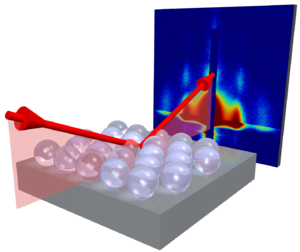GISAXS
Grazing-Incidence Small-Angle X-ray Scattering (GISAXS) is a surface-sensitive scattering technique used to probe the nanostructure of thin films.
It is a versatile and powerful technique, which enables studies of nanoscale objects deposited on surfaces (e.g. nanoparticles), thin and ultra-thin layers of nanomaterials (e.g. block-copolymers), or nano-structured surfaces (e.g. lithographic patterns).
Experiment
A typical GISAXS experiment involves directing a focused and collimated x-ray beam towards the surface of a thin film supported on a flat substrate. The grazing-incidence angle is carefully controlled using a sample-tilt stage, and is typically on the order of 0.05° to 0.50°. At these shallow angles, the x-ray beam is efficiently reflected off the sample and/or substrate surfaces. The beam interacts with the sample's structure, giving rise to scattering features (peaks, rings, etc.) that encode the nanoscale order in the sample.
